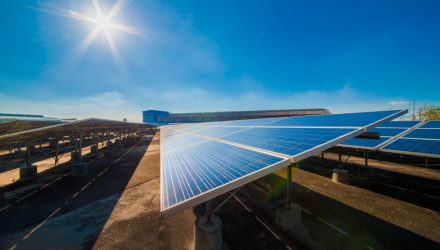The market’s savage repudiation of oil could have an unintended, though positive impact: more spotlight on alternative energy ETFs, such as the previously high-flying ALPS Clean Energy ETF (ACES).
ACES follows the CIBC Atlas Clean Energy Index. That benchmark is comprised of U.S. and Canada-based companies that primarily operate in the clean energy sector. Constituents are companies focused on renewables and other clean technologies that enable the evolution of a more sustainable energy sector.
“As the oil price rout continues, the case for investors and governments to shift more capital to the clean energy sector grows stronger, the International Renewable Energy Agency said in an April 20 report,” reports S&P Global Market Intelligence.
ACES’ components provide the products and services that enable the evolution of a more sustainable energy sector. The green energy companies are engaged in renewable energy sources, including solar power, wind power, hydroelectricity, geothermal energy, biomass, biofuels, and tidal/wave energy; clean technologies, including electric vehicles, energy storage, lithium, fuel cell, LED, smart grid, and energy efficiency technologies; and other emerging clean energy activities and technologies.
Analyzing ACES
ACES is at the right place at the right time. Not only is clean energy consumption increasing, but costs are also decreasing, which in turn bolsters adoption. Additionally, coal production is slumping, adding to the virtuous cycle for alternative energy ETFs.
“The International Renewable Energy Agency, or IRENA, issued the report the same day that futures prices for West Texas Intermediate crude plummeted into negative territory for the first time ever as markets sapped of demand by the coronavirus pandemic remain awash in oil,” according to S&P Global Market Intelligence.
ACES takes a different approach than what is seen in other traditional clean energy ETFs. Many of the legacy funds in this space focus on one alternative energy concept, such as solar or wind power. Buoyed by double-digit growth rates in global solar installations over the next decade, ACES, with a substantial solar weight, could be a long-term winner.
“Calling on governments to design pandemic rescue and stimulus packages that accelerate decarbonization efforts, IRENA presented a scenario for cutting 70% of energy-related carbon dioxide emissions globally by 2050, primarily through using renewables and energy efficiency and a sharp reduction in fossil fuel consumption,” according to S&P Global Market Intelligence.
For more on disruptive technologies, visit our Disruptive Technology Channel.
The opinions and forecasts expressed herein are solely those of Tom Lydon, and may not actually come to pass. Information on this site should not be used or construed as an offer to sell, a solicitation of an offer to buy, or a recommendation for any product.

